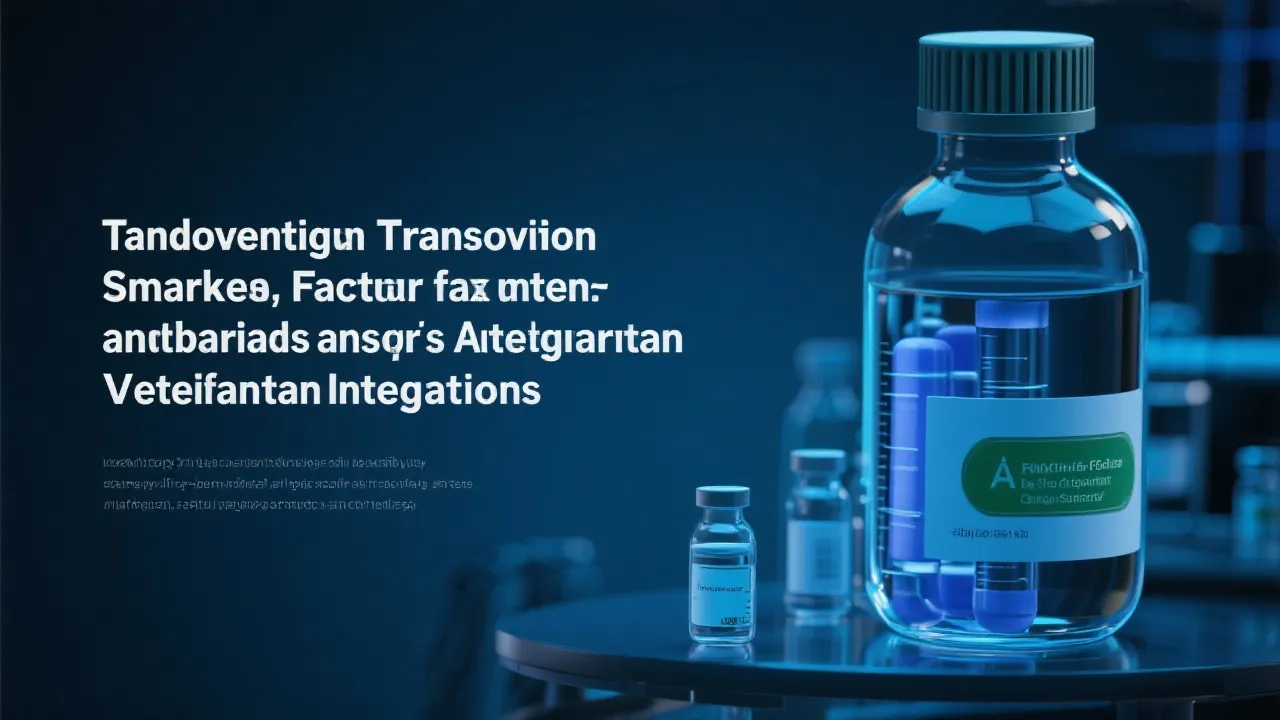Pivotal Forces Driving Biopharmaceutical Production's Evolution
The pharmaceutical industry is witnessing transformative shifts driven by factors like supply chain intricacies and advancements in technology. By implementing vertical integration and automation, firms aim to boost production and sustain competitiveness. These strategies are set to redefine the landscape of drug development and distribution.

The Rise of Comprehensive Control
In the biopharmaceutical sector, the strategy of vertical integration is rapidly gaining traction. In this strategy, companies oversee every phase of creating and producing drugs, from the research and trial stages to manufacturing and logistics. This trend stems from a desire to lessen dependency on CROs (Contract Research Organizations) and external services, as companies are increasingly recognizing the advantages of having complete ownership over their processes. By in-housing these phases, firms seek more control over timelines, quality, and data security, which is essential in today’s highly competitive and regulated landscape. This move can particularly benefit small to mid-sized firms that historically relied on outside entities, as it promotes a culture of innovation and agility. The control enabled by vertical integration allows for more streamlined trial operations, facilitating faster decision-making and a more agile regulatory response. Companies become not only the creators of therapies but also the guardians of the data generated throughout the process. This comprehensive oversight leads to improved communication across departments, resulting in fewer misalignments and a more cohesive effort toward shared objectives. Although initial investments are needed to establish in-house capabilities—ranging from advanced technology to skilled personnel—the long-term costs are optimized by reducing expenditure on outsourcing and enhancing operational processes. Moreover, as companies evolve and develop internal expertise, they cultivate an environment of continuous improvement that drives down costs over time. Additionally, in a market characterized by intense pricing pressure, managing costs efficiently becomes crucial. Companies that can maintain high operational standards while being cost-effective are better positioned to capture market share and serve patients effectively. Overall, vertical integration is about fostering lasting leadership in biotechnology. By governing the process end-to-end, companies can harness data insights to refine operations, drive innovation, and better meet market demands. The ultimate goal is not just to survive, but to thrive by creating a robust pipeline of new therapies that address unmet medical needs while ensuring a sustainable business model.
Data-Driven Decision-Making and Regulatory Nimbleness
The strategic benefit of complete process control extends beyond cost efficiency; it fundamentally revolutionizes biopharma operations and innovation avenues. With intimate oversight at every stage of drug creation, companies access a trove of exclusive data. This data, when analyzed, provides essential insights into drug effectiveness, safety metrics, and production hurdles—insights that are invaluable for making informed decisions. This knowledge empowers better decisions, faster innovation, and expedites therapy development. For instance, if data analysis reveals a recurring production issue, companies can quickly implement corrective measures, thus avoiding costly delays in bringing a drug to market. Additionally, end-to-end integration bolsters regulatory adaptability. As biopharma must adhere to stringent global regulations, possessing control over the entire production and development process ensures compliance from initial research to post-market checks. This prevents regulatory delays that could derail timelines and market launches, allowing companies to react quickly to changes in legislation or new standards. Moreover, by maintaining a robust compliance framework internally, firms can not only navigate existing regulations more efficiently but also position themselves to anticipate future changes. The ability to analyze large datasets—made possible through advanced analytics and machine learning—means that companies can identify patterns and trends that inform regulatory strategy. This proactive approach enhances data utility, leading to a more informed and effective dialog with regulatory bodies. By understanding regulatory expectations and having robust systems in place, companies demonstrate their commitment to quality and safety, thereby fostering trust with regulators and stakeholders alike. Ultimately, this integration enhances proactivity and adaptability in a fast-evolving domain, positioning firms as leaders not just in innovation but also in compliance.
The Influence of Intelligent Manufacturing
Biopharmaceutical production is being revolutionized by smart factory technologies, including advancements in artificial intelligence (AI) and automation, marking a significant shift beyond simple improvements. A major benefit of these technologies lies in heightened operational efficiency, with AI systems optimizing production schedules, forecasting equipment needs, and refining processes in real-time. The integration of machine learning algorithms can predict outcomes based on historical data, enabling manufacturers to anticipate variations and address them preemptively. Automation plays a crucial role in reducing human error risks and boosting productivity across various stages of production. The reduction of manual intervention not only optimizes labor costs but also leads to consistent product quality. These innovations enable faster and more reliable production capabilities at reduced costs, making it feasible to scale up operations in response to market demands without compromising quality or safety. Smart factories also bring unprecedented scalability to biopharmaceutical production. Traditional manufacturing processes often struggle to keep pace with sudden changes in demand, particularly during global health events like pandemics. Smart factories, however, are designed to be easily adaptable. They can quickly scale operations to accommodate spikes in demand driven by health events or regulatory approvals. This responsiveness is critical as it ensures that patient needs are promptly met, particularly for life-saving medications where delays can have dire consequences. In addition to flexibility, intelligent manufacturing can enhance transparency in the supply chain. By embedding IoT (Internet of Things) devices across manufacturing processes, companies can track every aspect of production, from raw materials to finished products. This level of visibility allows for immediate identification of bottlenecks or inefficiencies, and the ability to analyze this data allows for continuous improvement initiatives that drive operational excellence.
Localized Production and Patient-Centered Integration
Technological advancements in smart factories are key to the regionalization of biopharmaceutical supply strategies. Increasingly, there’s an emphasis on situating production facilities nearer to end-user markets. This method not only sidesteps the vulnerabilities of global supply chains, which can be disrupted by geopolitical events or natural disasters, but also supports local demand more effectively. Companies are recognizing that closer proximity to patients can lead to enhanced responsiveness and an ability to align more closely with local healthcare needs. Smart factories allow companies to set up nimble, region-specific operations that cater to efficient patient access. By leveraging regional production facilities, firms can minimize transportation times and costs, ensuring that medications reach patients when they are needed most. This localized approach can also facilitate quicker responses to market changes, whether driven by demographic shifts, regulatory updates, or emerging health trends. Beyond regional focus, this evolved approach fuels patient-centered digital integration that enhances supply chain tracking from production to delivery. The resultant transparency combats counterfeit risks and secures timely drug delivery, ensuring that patients receive safe and effective therapies. By integrating patient data into the production and delivery processes, companies can take a more personalized approach to treatment. This integration not only enhances medication efficacy through tailored dosages but also empowers patients with information about their treatments, fostering better adherence and outcomes. Moreover, by leveraging data analytics, companies can identify specific patient populations that may benefit from certain therapies, enabling more targeted outreach and better health outcomes. This patient-centric model not only enhances satisfaction but ultimately drives improvements in public health, as therapies are more effectively aligned with the needs of the populations they serve.
Biosimilars and Tactical Consolidations
The biopharmaceutical landscape is being fundamentally reshaped by the surge of biosimilars and generics, which are encouraging strategic mergers aimed at enhancing vertical unification. Biosimilars, akin to original biologics, provide cost-effective alternatives that spurred firms to integrate their operations to preserve competitiveness and profitability. The regulatory pathway for biosimilars remains complex, requiring companies to invest significantly in their development and approval processes, leading to a drive for efficiency in research and production. Mergers often provide infusion financial resources and technical knowledge that bolster manufacturing capabilities, enhancing firms' ability to secure their supply chains and optimize processes. By consolidating resources, companies can eliminate redundancies and create a more streamlined operation that not only reduces costs but also improves product quality and consistency. Integration here serves as a defense strategy against market shifts driven by simpler counterparts that might threaten a firm’s market share. Furthermore, the pursuit of resilient supply chains and sustained profitability is fueling consolidation in the sector, with firms targeting entities possessing advanced technology or strategic geographic presence. This tactical consolidation aims to ensure that firms can meet the growing demand for biosimilars—a segment projected to grow exponentially as patent protections on original biologics expire. Companies are actively seeking strategic alliances that allow them to enter new markets while simultaneously gaining insights from diverse operational models. Such consolidation can yield significant synergies, leading to enhanced R&D efforts and innovative capacity. As the landscape evolves, understanding the nuances of biosimilar development becomes crucial. Companies that stay ahead of the regulatory landscape and optimize their integration strategies are well-positioned to capitalize on the expanding opportunities within this lucrative segment, ultimately fostering long-term growth.
Enhancing Market Standing Through Integration
The trend of integration through mergers extends beyond immediate cost savings; it significantly strengthens a company’s competitive stance in the biopharmaceutical landscape. With full control over the value chain—from R&D through to distribution—organizations can outpace competitors in terms of market response and innovation. This comprehensive oversight allows companies to react swiftly to changes in patient needs, emerging technologies, and market dynamics. They are advantageously positioned to negotiate with payers due to their capacity to offer bundled deals and value-oriented pricing models. Moreover, when companies integrate their operations effectively, they can leverage economies of scale that contribute to improved profitability. For instance, combined R&D efforts can yield greater innovation throughput as firms harness diverse expertise and resources. This formed strategic integration not only stems from the dynamics surrounding biosimilars but also manifests in various collaborative efforts that seek to enhance the overall value proposition offered to patients and payers alike. Within this rapidly transforming industry, firms are redefining success metrics. The emphasis is increasingly on the ability to provide value-based care, where treatment efficacy is measured against patient outcomes and overall healthcare costs. Firms that embrace integration are better equipped to deliver on these requirements, as they can align their operational processes with the goals of health systems and insurers. By prioritizing value-centric models and investing in holistic approaches, these companies can ensure they remain relevant and competitive. Through this shift towards integrated models, the biopharmaceutical industry is transitioning toward a future characterized by agility, resilience, and sustained excellence. Companies that effectively manage their integration strategies will undoubtedly emerge stronger, prepared to meet the evolving expectations of the healthcare marketplace.
References:
- Mergers and Acquisitions in Drug Development: Opportunities in the generic sector continue to expand as the biosimilar landscape evolves, creating new pathways for growth.
- Semi-Solid Manufacturing Market: The biopharmaceutical industry anticipates growth in contract manufacturing, as firms seek efficiency and expertise in navigating complex regulatory environments.
- Strategic Industry Article: Insights on scientific developments and biotechnology advancements illuminate the direction of the biopharmaceutical sector and reveal trends impacting future strategies.




